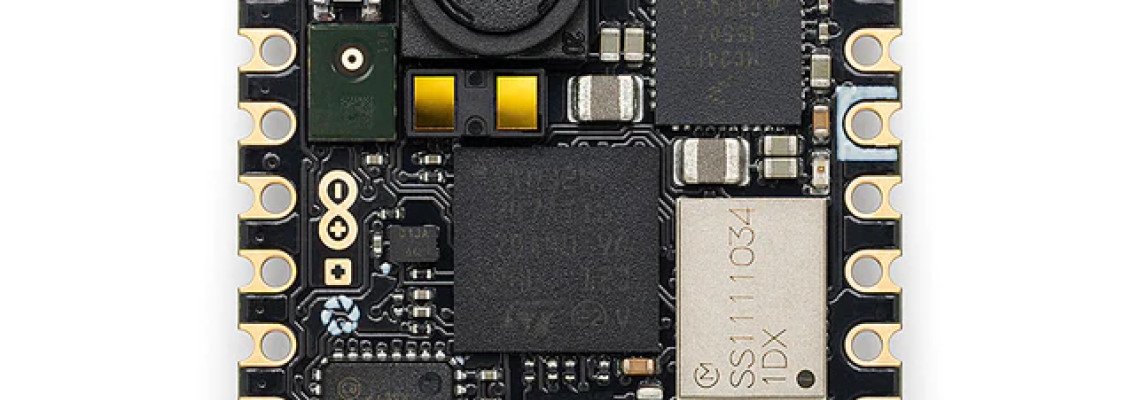
Nicla Vision
L'Arduino® Nicla Vision est une caméra autonome prête à l'emploi pour l'analyse et le traitement d'images en périphérie. Grâce à sa caméra couleur 2 MP, son capteur de mouvement intelligent à 6 axes, son microphone intégré et son capteur de distance, il convient au suivi des actifs, à la reconnaissance d'objets et à la maintenance prédictive. Implémentez rapidement des nœuds de capteurs pour envoyer les données collectées au Cloud Arduino® (ou à des services de fournisseurs tiers) via la connectivité Wi-Fi®/Bluetooth® LE intégrée.
Réseaux de capteurs sans fil, fusion de données, intelligence artificielle, vision artificielle
Caractéristiques
Microcontrôleur STM32H747AII6 double cœur
- Noyau Arm® Cortex®-M7 32 bits avec FPU double précision et cache L1 jusqu'à 480 MHz
- Noyau Cortex®-M4 Arm® 32 bits 32 bits avec FPU jusqu'à 240 MHz
- Ensemble complet d'instructions DSP
- Unité de protection de la mémoire (MPU)
Module Wi-Fi/BT Murata® 1DX
- Wi-Fi 802.11b/g/n 65 Mbit/s
- Bluetooth 4.2 BR/EDR/LE
Jauge de carburant MAX17262REWL+T
- Met en œuvre ModelGauge m5 EZ pour la surveillance de la batterie
- Faible courant de fonctionnement de 5,2 μA
- Aucun étalonnage requis
NXP® SE050C2 Crypto
- Critères Communs Certifié EAL 6+ jusqu'au niveau OS
- Fonctionnalités RSA et ECC, longueur de clé élevée et courbes à l'épreuve du temps, telles que brainpool, Edwards et Montgomery
- Cryptage et décryptage AES & 3DES
- Opérations HMAC, CMAC, SHA-1, SHA-224/256/384/512
- HKDF, MIFARE® KDF, PRF (TLS-PSK)
- Prise en charge des principales fonctionnalités TPM
- Mémoire utilisateur flash sécurisée jusqu'à 50 Ko
- SCP03 (chiffrement de bus et injection d'informations d'identification chiffrées au niveau de l'applet et de la plate-forme)
Capteur de temps de vol VL53L1CBV0FY/1
- Module miniature entièrement intégré
- Émetteur laser invisible 940 nm (VCSEL)
- Matrice de réception avec lentille intégrée
- Détection à 400 cm avec un champ de vision complet (FoV)
Micro MP34DT06JTR
- AOP = 122,5 dBSPL
- Rapport signal/bruit de 64 dB
- Sensibilité omnidirectionnelle
- –26 dBFS ± 1 dB de sensibilité
Caméra GC2145
- Appareil photo CMOS 2 mégapixels
- ADC 10 bits sur puce
- Taille de pixel de 1,75 μm
- Focale : 2,2 mm
- Valeur F : 2,2 ± 5 %
- Angle de vue : 80°
- Distorsion : < 1,0 %
IMU 6 axes LSM6DSOX
- Accéléromètre 3D et gyroscope 3D toujours activés
- FIFO intelligent jusqu'à 4 Ko
- ±2/±4/±8/±16 g pleine échelle
- ±125/±250/±500/±1000/±2000 dps pleine échelle
Émetteur-récepteur USB USB3320C-EZK-TR
- Circuit de protection ESD intégré (jusqu'à ±15kV IEC Air Discharge)
AT25QL128A-UUE-T Flash 16 Mo
Circuit intégré de gestion de l'alimentation MC34PF1550A0EP
Exemples d'applications :
L'Arduino® Nicla Vision abrite la puissance de calcul, la caméra et l'IMU dont vous avez besoin pour développer rapidement des solutions de vision industrielle à la périphérie avec deux technologies sans fil. La carte peut agir comme une carte autonome prête pour le terrain ou peut être complétée par des périphériques externes via les E/S disponibles sur la puce. La consommation d'énergie ultra-faible et la gestion intégrée de la batterie permettent un déploiement dans diverses capacités. WebBLE permet des mises à jour OTA faciles du micrologiciel ainsi que la surveillance à distance.
Entrepôt et gestion automatisée des stocks : l'Arduino Nicla Vision est capable de détecter les colis lorsqu'ils s'approchent de son voisinage et se réveillent. Ceux-ci offrent les avantages d'une caméra toujours allumée, mais avec une consommation d'énergie moindre. Il peut prendre des photos, prédire le volume/poids et également analyser d'éventuels défauts. De plus, les codes QR sur le colis peuvent être suivis pour une poursuite automatisée du colis et le relais des informations vers le cloud.
Gestion des processus en temps réel : L'Arduino Nicla Vision est équipé pour l'inspection optique automatisée (AOI) même dans les zones difficiles d'accès et dangereuses grâce à la faible empreinte et aux options de connectivité sans fil. Le capteur de temps de vol rapide garantit que l'acquisition d'image est effectuée de manière reproductible, avec des modifications minimales du processus. De plus, l'IMU peut fournir une analyse des vibrations pour la maintenance prédictive.
Conception de référence du réseau de capteurs sans fil : le facteur de forme Nicla a été spécifiquement développé chez Arduino® en tant que norme pour les réseaux de capteurs sans fil qui peuvent être adaptés par les partenaires pour développer des solutions industrielles conçues sur mesure. Les chercheurs et les éducateurs peuvent utiliser cette plate-forme pour travailler sur une norme reconnue par l'industrie pour la recherche et le développement de capteurs sans fil qui peut raccourcir le délai entre le concept et le marché.
Présentation de l'assemblage
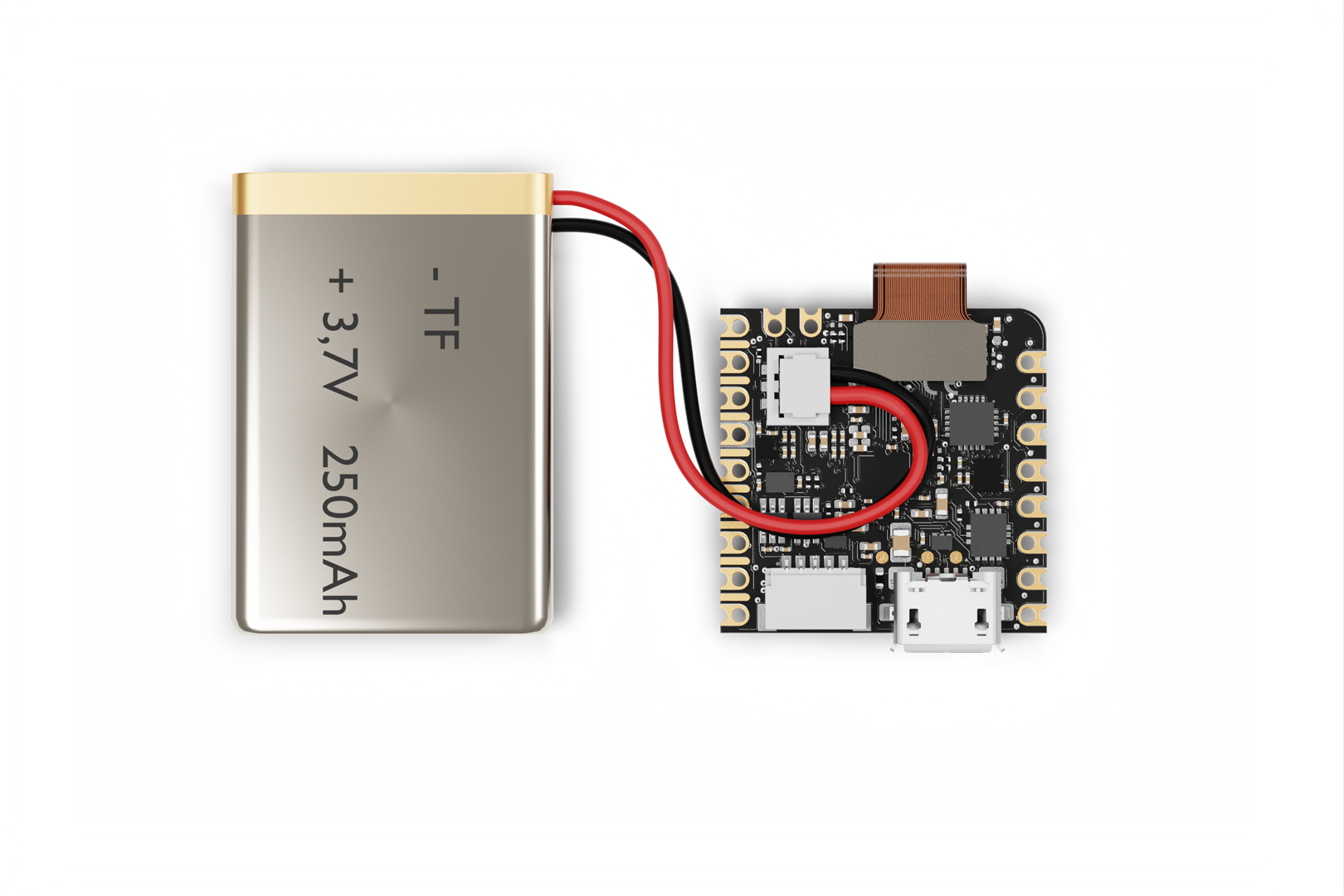
Diagramme
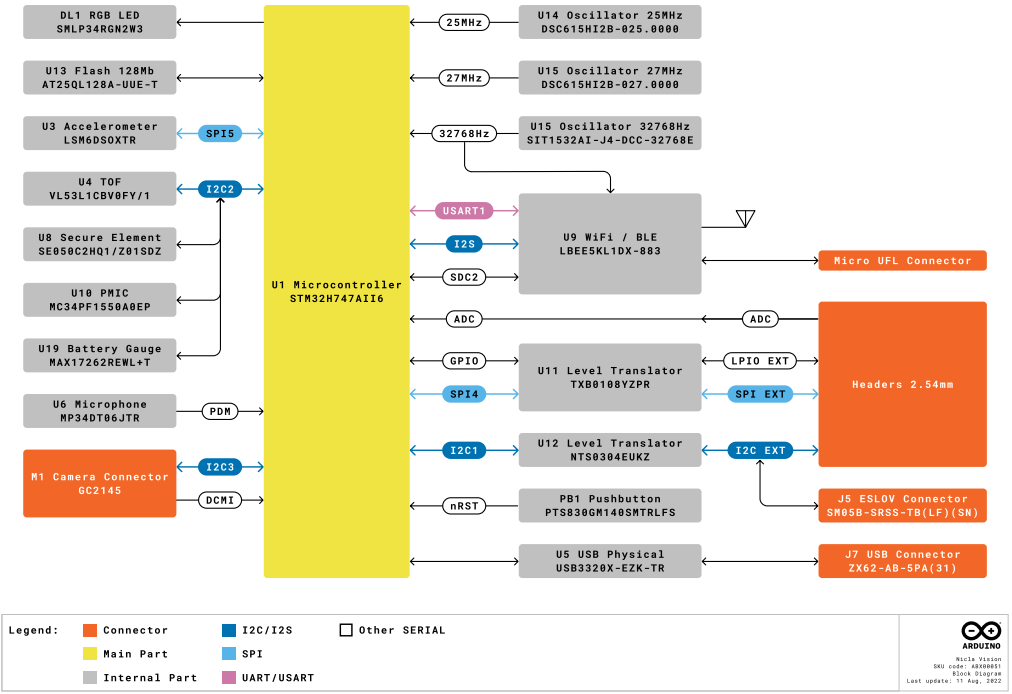
Topologie de la carte
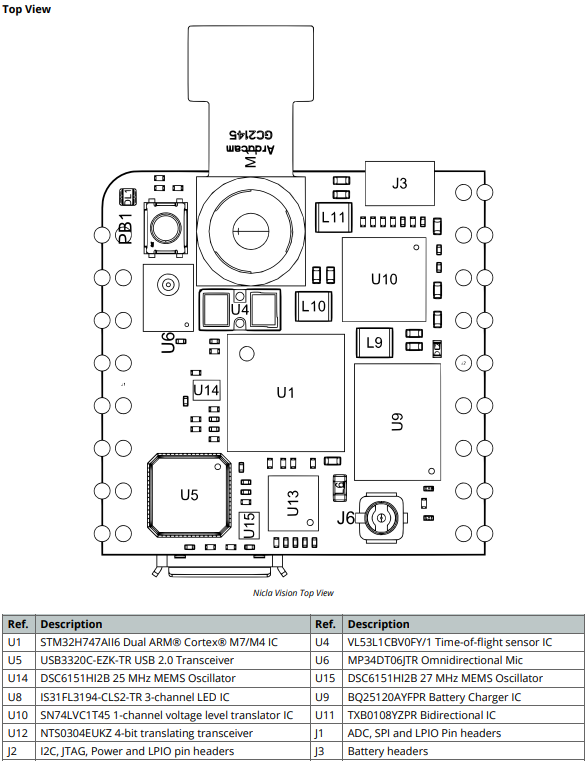
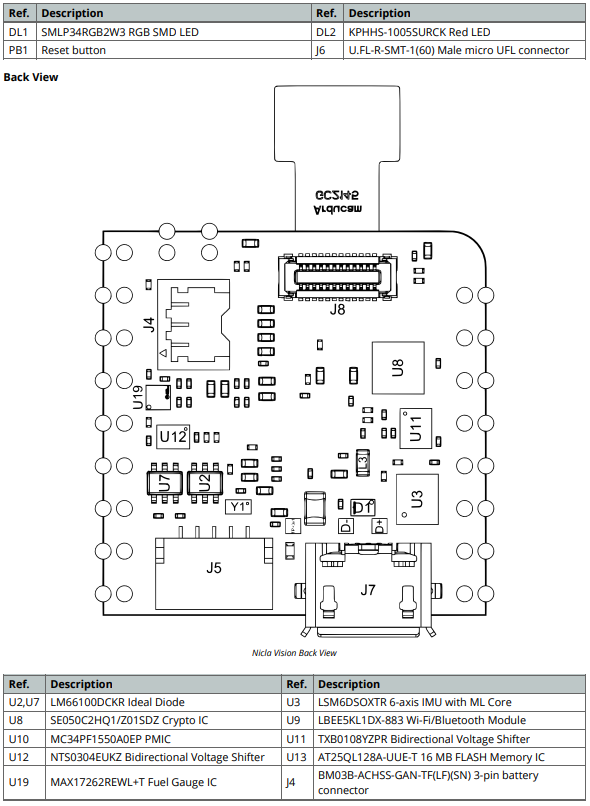
Processeur
Le processeur principal de Nicla Vision est le STM32H747 (U1) double cœur comprenant un Cortex® M7 fonctionnant à 480 MHz et un Cortex® M4 fonctionnant à 240 MHz. Les deux cœurs communiquent via un mécanisme d'appel de procédure à distance qui permet d'appeler des fonctions sur l'autre processeur de manière transparente.
IMU 6 axes
Il est possible d'obtenir des données de gyroscope 3D et d'accéléromètre 3D à partir de l'IMU 6 axes LSM6DSOX (U3). En plus de fournir ces données, il est également possible d'effectuer un apprentissage automatique sur l'IMU pour la détection des gestes, déchargeant ainsi la charge de calcul du processeur principal.
Connectivité Wi-Fi/Bluetooth®
Le module sans fil Murata® LBEE5KL1DX-883 (U9) fournit simultanément une connectivité Wi-Fi et Bluetooth® dans un boîtier ultra-compact basé sur le Cypress CYW4343W. L'interface Wi-Fi® IEEE802.11 b/g/n peut être utilisée comme point d'accès (AP), station (STA) ou AP/STA simultané bimode. Il prend en charge un taux de transfert maximal de 65 Mbps. L'interface Bluetooth® prend en charge Bluetooth Classic et BLE. Un commutateur de circuit d'antenne intégré permet de partager une seule antenne externe (J6) entre Wi-Fi et Bluetooth®.
Capacités de chiffrement
L'Arduino® Nicla Vision permet une capacité de sécurité de niveau IC de la périphérie au cloud grâce à la puce NXP SE050C2 Crypto (U8). Cela fournit la certification de sécurité Critères communs EAL 6+ jusqu'au niveau du système d'exploitation, ainsi que la prise en charge de l'algorithme cryptographique RSA/ECC et le stockage des informations d'identification.
Capteur de temps de vol
Le capteur de temps de vol VL53L1CBV0FY (U4) ajoute des capacités de télémétrie précises et à faible puissance à l'Arduino® Nicla Vision. Le laser VCSEL invisible proche infrarouge (y compris le pilote analogique) est encapsulé avec l'optique de réception dans un petit module tout-en-un situé sous la caméra.
Micros numériques
Le microphone MEMS numérique MP34DT05 est omnidirectionnel et fonctionne via un élément de détection capacitif avec un rapport signal/bruit élevé (64 dB). L'élément de détection, capable de détecter les ondes acoustiques, est fabriqué à l'aide d'un procédé de micro-usinage de silicium spécialisé dédié à la production de capteurs audio.
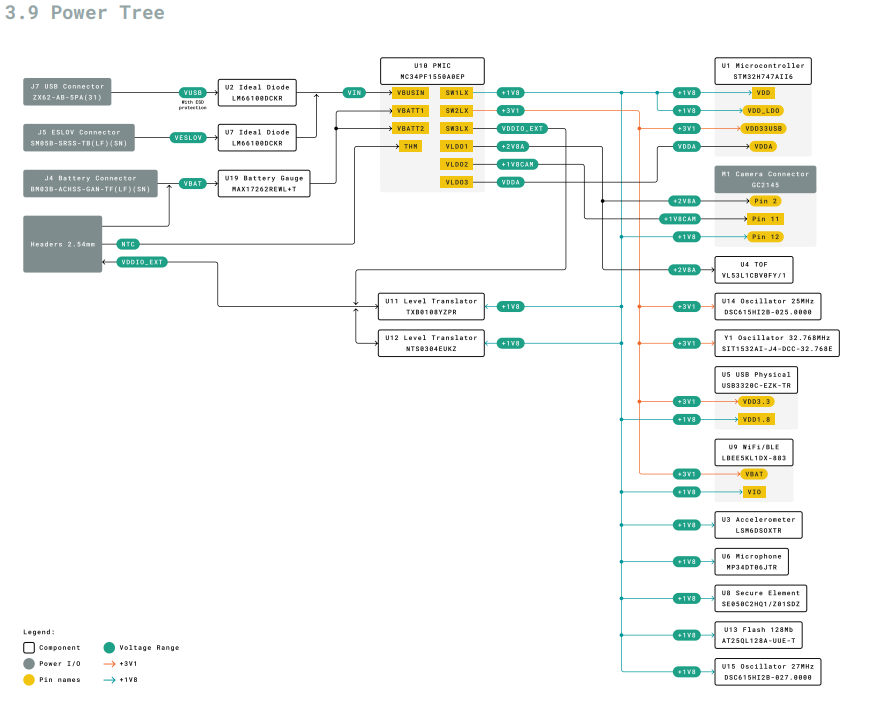
La tension d'entrée peut être fournie au Nicla Vision via le connecteur USB (J7), le connecteur ESLOV (J5), le connecteur de la batterie (J4) ou alternativement les en-têtes. Le connecteur USB est prioritaire sur le connecteur ESLOV, qui sont tous deux prioritaires sur le connecteur de batterie et l'en-tête. La protection contre l'inversion de polarité pour le connecteur USB (J7) et le connecteur ESLOV (J5) est assurée par les diodes idéales U2 et U7 respectivement. La tension d'entrée de la batterie n'a PAS de protection contre l'inversion de polarité et l'utilisateur est responsable du respect de la polarité. Un capteur NTC (coefficient thermique négatif) fournit une coupure de surchauffe à la batterie. La jauge de charge de la batterie fournit une indication de la capacité restante de la batterie.
Trois lignes électriques principales sont fournies :
- +3V1 alimente le microprocesseur (U1), l'oscillateur 25 MHz (U14), l'oscillateur 32,768 MHz (Y1), l'émetteur-récepteur USB (U5) et le module Wi-Fi/Bluetooth.
- +2V8A alimente la caméra (M1) et le capteur de temps de vol (U4)
- +1V8 alimente le microprocesseur (U1), la caméra (M1), l'émetteur-récepteur USB (U5), le module Wi-Fi/Bluetooth (U9), l'accéléromètre (U3), le microphone (U6), le crypto (U8), le FLASH (U13 ), l'oscillateur 27 MHz (U15) ainsi que les deux translateurs de niveau (U11, U12).
- De plus, un rail d'alimentation analogique dédié (VDDA) est prévu pour le microcontrôleur (U1). Le module caméra (M1) dispose également d'un rail d'alimentation dédié (+1V8CAM).
Fonctionnement du conseil :
Mise en route - EDI
Si vous souhaitez programmer votre Arduino® Nicla Vision hors ligne, vous devez installer l'Arduino® Desktop IDE [1]. Pour connecter l'Arduino® Vision à votre ordinateur, vous aurez besoin d'un câble micro USB. Cela alimente également la carte, comme indiqué par la LED.
Mise en route - Éditeur Web Arduino
Toutes les cartes Arduino®, y compris celle-ci, fonctionnent prêtes à l'emploi sur l'éditeur Web Arduino® [2], en installant simplement un plugin simple.
L'éditeur Web Arduino® est hébergé en ligne, il sera donc toujours à jour avec les dernières fonctionnalités et la prise en charge de toutes les cartes. Suivez [3] pour commencer à coder sur le navigateur et téléchargez vos croquis sur votre tableau.
Mise en route - Nuage Arduino
Tous les produits compatibles Arduino® IoT sont pris en charge sur Arduino® Cloud, ce qui vous permet d'enregistrer, de représenter graphiquement et d'analyser les données des capteurs, de déclencher des événements et d'automatiser votre maison ou votre entreprise.
Mise en route - WebBLE
L'Arduino Nicla Vision offre la possibilité d'effectuer des mises à jour OTA du microcontrôleur STM32 à l'aide de WebBLE.
Mise en route - ESLOV
Cette carte peut servir de secondaire à un contrôleur ESLOV et mettre à jour le micrologiciel via cette méthode.
Exemples de croquis
Des exemples de croquis pour l'Arduino® Nicla Vision peuvent être trouvés soit dans le menu "Exemples" de l'IDE Arduino®, soit sur le site Web de documentation Arduino®
Ressources en ligne
Maintenant que vous avez parcouru les bases de ce que vous pouvez faire avec la carte, vous pouvez explorer les possibilités infinies qu'elle offre en consultant des projets passionnants sur ProjectHub [5], la référence de la bibliothèque Arduino® [6] et la boutique en ligne [7] où vous pourrez compléter votre carte avec des capteurs, des actionneurs et plus encore.
Récupération de carte
Toutes les cartes Arduino® ont un chargeur de démarrage intégré qui permet de flasher la carte via USB. Dans le cas où une esquisse verrouille le processeur et que la carte n'est plus accessible via USB, il est possible d'entrer en mode chargeur de démarrage en appuyant deux fois sur le bouton de réinitialisation juste après la mise sous tension.
Brochage des connecteurs
Remarque 1 : Toutes les broches de J1 et J2 (à l'exception des ailettes) sont référencées à la tension VDDIO_EXT qui peut être générée en interne ou fournie en externe. Remarque 2 : I2C1 est connecté au traducteur de niveau U12 qui a des pullups internes de 10k. Les résistances pullup R9 et R10 ne sont pas montées sur la carte.

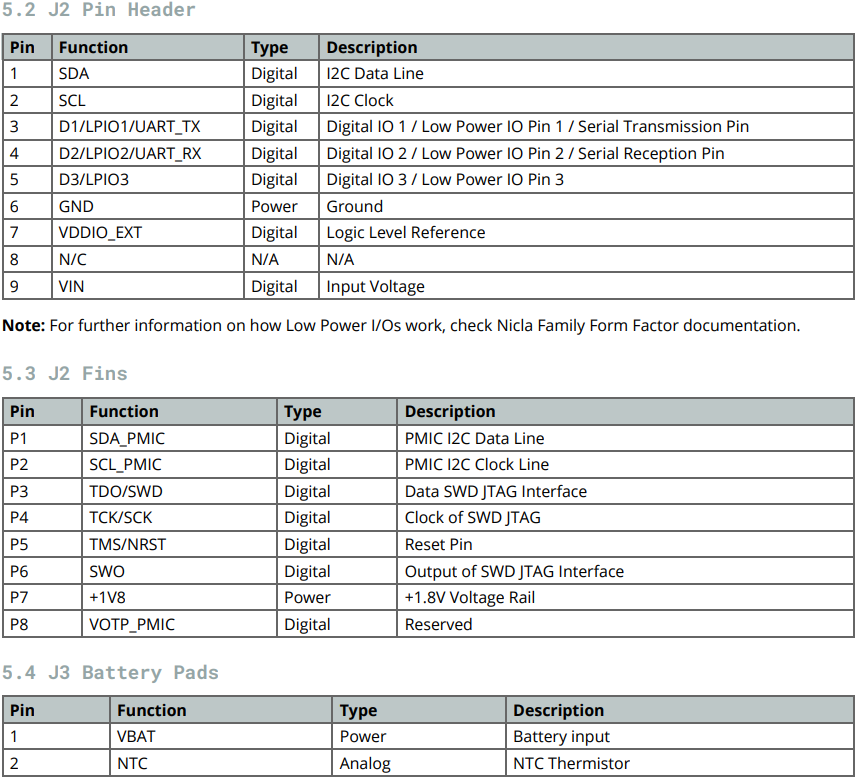


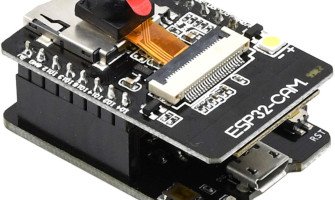
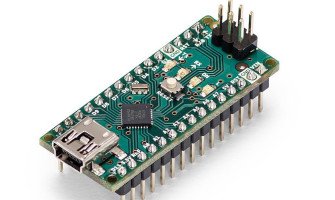
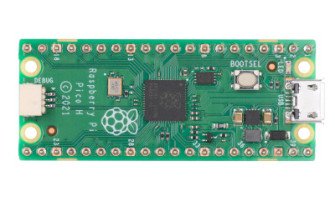
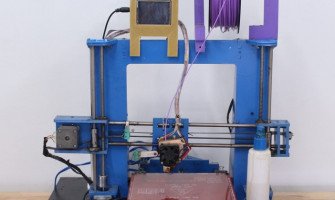
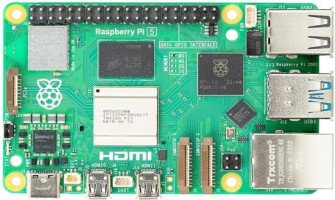
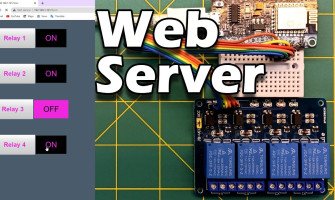
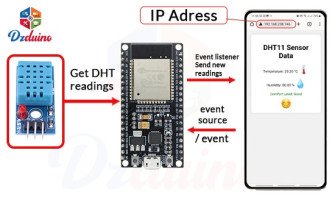
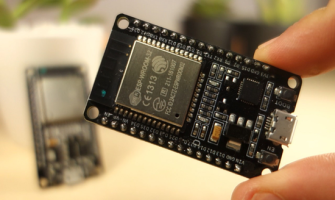
Laissez un commentaire